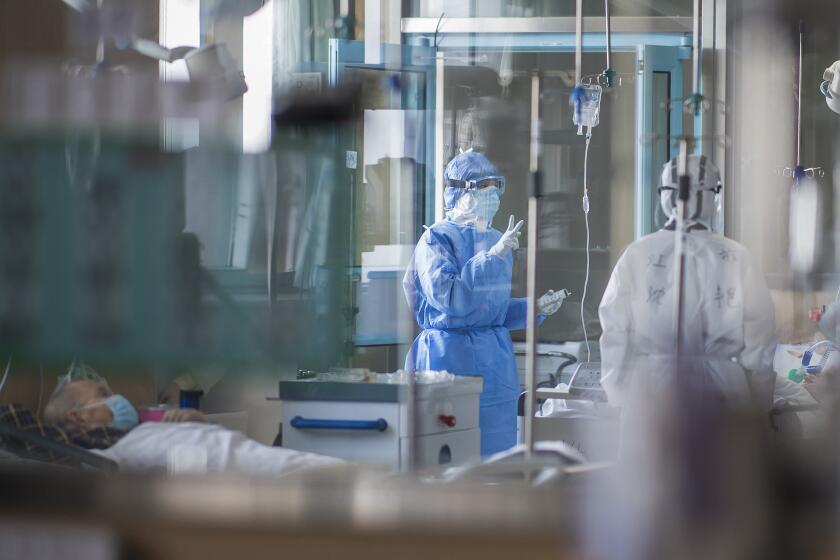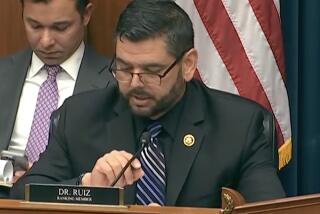New genetic research points to Wuhan animal market as origin of COVID pandemic, study says

- Share via
A new analysis of genetic material gathered from a live-animal market in Wuhan in the early weeks of the COVID-19 pandemic strengthens the case that the outbreak originated there when the coronavirus jumped from infected animals to humans, scientists said.
The findings, reported the journal Cell, do not identify any specific infected animal that brought the SARS-CoV-2 virus to a Chinese city inhabited by more than 11 million people. Nor do they definitively prove that the Huanan Seafood Wholesale Market was Ground Zero for a pandemic that has resulted in more than 7 million deaths.
But the genetic evidence shows the market met the conditions necessary to spark an outbreak and makes it increasingly difficult to explain how the coronavirus could have emerged from a laboratory, a farm or even from another of the city’s four live-animal markets, the study authors said.
“It’s like if a gorilla virus emerged in San Diego and first hit people who worked at the San Diego Zoo and lived nearby, then spread later more widely,” said Michael Worobey, an evolutionary biologist at the University of Arizona who worked on the study. “It would not be difficult to reason that it very likely came from the gorillas at the zoo.”
The root cause of the pandemic has been hotly debated since its early days. Wuhan is home to a government laboratory where scientists study coronaviruses similar to SARS-CoV-2, a fact that prompted politicians, national security experts, late-night talk show hosts and many scientists — including Worobey — to question whether the virus had leaked from the lab.
Compelling though the argument may be, hard evidence to support the leak hypothesis has been lacking. Meanwhile, more information has come to light that has persuaded scientists with expertise in relevant fields that the virus that causes COVID-19 originated in animals, just like the viruses that cause SARS, MERS and influenza.
The new results continue that trend, said Dr. Dominic Dwyer, a member of the international task force that investigated the pandemic’s origins for the World Health Organization.
“You put all of these origin hypotheses on the table, and then some of them become stronger as you get evidence,” said Dwyer, a medical virologist at the University of Sydney and Westmead Hospital in Australia who wasn’t involved in the latest work. “This paper has more evidence that supports the animal origin through the Huanan market.”
A close analysis of Wuhan’s earliest COVID-19 cases points to a live-animal market as the most likely source of the novel coronavirus, a study argues.
The analysis published Thursday was based on genetic data gleaned from hundreds of samples gathered in and around the Huanan market collected by researchers from the Chinese Center for Disease Control and Prevention soon after the market was shut down on Jan. 1, 2020. The Chinese team detected the coronavirus in 74 of the environmental samples they tested, according to their report last year in the journal Nature.
Worobey and his colleagues dug deeper into that data. Using two distinct gene-sequencing techniques, they looked for pieces of SARS-CoV-2 as well as for DNA from animals and people.
Then they plotted what they found on a map of the sprawling market, allowing the team to reconstruct how a few initial infections could have ballooned into a global health emergency.
Among 585 samples gathered in early January 2020, the ones that contained the coronavirus were clustered in the southwestern section of the market. That happened to be the area where wild animals were held in cages for sale.
“The market covers a couple of acres, and this comes down to one corner of the market, and to a couple of stalls,” Dwyer said. “That fits with an animal origin. If it was coming from people wandering around the market, you’d find it everywhere.”
One market stall “stood out,” the study authors wrote. It had evidence of SARS-CoV-2 in multiple places: on at least one cart, on an iron container, on the ground, and on a machine used to remove hair and feathers. The researchers dubbed it “wildlife stall A.”
Another 60 samples were taken from the market’s drainage system at the end of January 2020. The researchers found genetic evidence of the coronavirus in four of them, including one in front of wildlife stall A.
That drain was still testing positive for SARS-CoV-2 in mid-February. So were two drains downstream from it that could have been contaminated by runoff from wildlife stall A, the researchers wrote.
Two new studies build on evidence that the coronavirus that causes COVID-19 jumped to humans in a Wuhan market, and did so twice.
The samples from the stall that contained the coronavirus also contained DNA from a variety of animals, including dogs, rabbits, hoary bamboo rats, Malayan porcupines and masked palm civets. The most abundant DNA was from raccoon dogs, and some was detected in a nearby garbage cart that also tested positive for the virus.
The closest-known relatives to SARS-CoV-2 that exist in the wild are coronaviruses that circulate in horseshoe bats in southern China, Laos and Vietnam and in pangolins from southern China. But no DNA from bats or pangolins turned up in any of the Huanan market samples.
Raccoon dogs, masked palm civets, hoary bamboo rats and Malayan porcupines have transmitted bat coronaviruses before, the study authors noted. Could they have done so in Wuhan, they wondered?

It is unclear whether bamboo rats or Malayan porcupines can be infected with SARS-CoV-2, the study authors wrote. There is no hard evidence that masked palm civets can catch the virus, but cell lines from the animals were susceptible in laboratory experiments.
Raccoon dogs, on the other hand, are known to catch and transmit SARS-CoV-2. And they were the most abundant animal in wildlife stall A.
The researchers dug into the raccoon dog DNA to see if they could have come from southern China, where they might have crossed paths with bats. They couldn’t tell, but they were able to rule out a connection to raccoon dogs that lived on fur farms in northern China.
Worobey and his colleagues also studied non-SARS-CoV-2 animal viruses that were detected in wildlife stalls to see if they offered clues about where the infected animals had come from.
A kobuvirus that infected civets in the Huanan market was closely related to a virus detected in animals sold in Sichuan and Guangxi provinces, which are closer to the territory of horseshoe bats and pangolins. And a betacoronavirus that infected bamboo rats had a close relative on a bamboo rat farm in Guangxi, one of two southern provinces where market vendors were known to have sourced the animals.
“These findings suggest some movement of infected animals from southern China to Wuhan, a trade conduit that could have also led to the emergence of SARS-CoV-2,” the study authors wrote.
Nailing this down will require more sleuthing, including field work to collect samples from animals in China, said Florence Débarre, an evolutionary biologist at the French National Centre for Scientific Research in Paris and the study’s senior author. Worobey said he plans to continue this line of inquiry.
Dwyer praised the effort to determine where the animals in the market had come from — and by extension, how the virus could have gotten to the market.
Contrary to conclusions by the Department of Energy and the FBI, the science on the pandemic’s origins stacks up in favor of a jump from animals to humans.
A second line of evidence also supports the hypothesis that the pandemic had a so-called zoonotic origin, scientists said.
Among the samples collected at the Huanan market on Jan. 1, 2020, the researchers were able to identify four nearly complete SARS-CoV-2 genomes. One of them was from so-called lineage A, and the other three were from the closely related lineage B.
The researchers weren’t able to tell whether those viruses were shed by animals or people, but the lineage A sample came from a stall where a worker sought medical attention in mid-December 2019. Although that was weeks before COVID-19 had been recognized as a disease, a report from the World Health Organization later described the worker as a suspected early patient.
Confirming the presence of both lineages in the market allowed the team to compare their genomes and work backward to figure out when the two strains diverged, and what their most recent common ancestor looked like. They came up with six candidates, some of them more plausible than others.
There was a 99% probability that one of the four most likely candidates was correct, and those four all had something important in common: They were “equivalent or identical” to the most recent common ancestor for the pandemic as a whole, said study leader Alexander Crits-Christoph, an independent computational microbiologist.
That’s what they would expect to find if the outbreak began at the Huanan market, the study authors said. In that scenario, an animal or animals infected with the virus arrived at the market in November or early December. The virus then spread among animals held in close quarters indoors, as well as to their human handlers. Those conditions would have given the virus the multiple chances it needed to establish itself in people and begin spreading among its new hosts in a densely populated city.
A timeline of COVID-19’s early weeks in China, beginning with the emergence of the first patient on or around Nov. 18.
On the other hand, it’s getting more difficult to fit all of this evidence into a coherent story that has the coronavirus entering China via imported frozen food (as the Chinese government has claimed) or escaping from a virology lab with lax biosecurity protocols (as some members of the U.S. intelligence community have proposed), Dwyer said.
“We’ve had nothing added to support the lab leak or the frozen food theories,” he said. “It just continues to strengthen the animal and market hypothesis.”
Considering that the pandemic began in a city with a virology lab where scientists study coronaviruses, it makes sense to ask whether that’s more than a coincidence and to wonder whether incriminating evidence is being covered up, DéBarre said.
“Many of us were extremely open to this idea,” she said. “But then data have accumulated, and they all go in the same direction — they all point to the market.”
“In science you very rarely have final answers,” she added. “You say, ‘Given all the data we have, this looks like the most likely interpretation.’”











